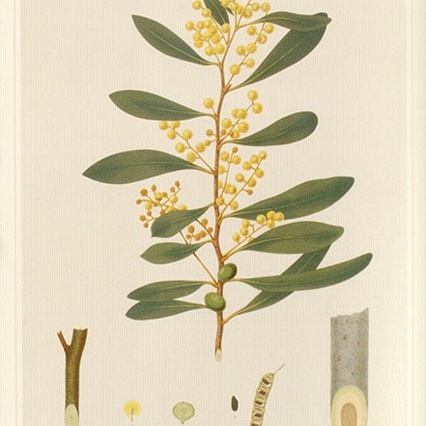Bushy spreading shrub to 3 m high. Branchlets dark red-brown, glabrous. Phyllodes narrowly elliptic to oblanceolate or narrowly oblanceolate, 6–13 cm long, 8–25 mm wide, normally obtuse, coriaceous, grey-green to glaucous, glabrous; midrib and marginal veins prominent; lateral veins obscure; gland normally 0–3 mm above pulvinus; pulvinus 2–6 mm long. Inflorescences mostly racemose; raceme axes 2–6 cm long, robust, glabrous; peduncles 2.5–6 mm long, rather stout, glabrous; heads globular, 27–36-flowered, bright golden; bracteole laminae evident in buds, dark brown to black, white-fimbriolate. Flowers 5-merous; sepals at least c. ¾-united. Pods stipitate, narrowly oblong, raised on opposite sides over alternate seeds, to 7 cm long, 8–13 mm wide, firmly chartaceous to slightly coriaceous, glabrous. Seeds transverse, oblong-elliptic, 4–7 mm long; funicle encircling seed, dark red-brown; aril clavate.
More
An evergreen shrub. It grows to 4 m high and 2 m across. The stem is smooth and erect. The branches hang downwards. The leaves (phyllodes) are greyish-green. They are thick and leathery. Leaves are 5-15 cm long and 0.5-2.5 cm wide. They are blunt at the end. There is one vein and along the edges here are vein like structures. The flowers are golden balls. They are about 1 cm across. They appear in large dense clusters. The pods are straight. They are 3-7 cm long and narrow (1 cm). They are flat but raised over the seeds. They have a thickened nerve like edge.

